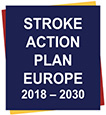Action Plan Publication update - Online Plenum meeting
The “Action Plan for Stroke in Europe” publication is being updated to a 2.0 version.
As significant scientific developments have happened since 2018 and new data has been released, the Domain Working groups, composed of original contributors and new members, have again been asked to provide their input on the respective domains.
The update is now entering its final phase and all stakeholders will have the opportunity to comment and contribute to that discussion, during the upcoming online plenum meeting: Tuesday 27 August 2024, from 9:00 to 15:00 CEST.
The programme will feature presentations by the Domain groups and discussions on each domain, as well as the section on translational research, as well as discussions with participants.
The detailed programme can be found here.
The meeting will be upon registration only: Click here to register.
New SAP-E Data release on European Stroke Awareness Day 2024
Europe takes small steps forward to improve stroke care and support, but too many inequities still persist
The latest data from the Stroke Action Plan for Europe (SAP-E) Stroke Service Tracker (SST) shed light on Europe’s journey toward better stroke care and support. While there are positive signs of progress, the report also reveals persistent gaps and challenges, highlighting the continued need for nationally targeted interventions.
The SST, which examines 12 key areas of stroke care improvement, shows positive strides in meeting SAP-E targets and improving acute treatment, organisation and quality control of services. Several countries, including the Republic of Moldovia, Bulgaria, Czech Republic, Estonia, Norway, Portugal, Romania, Sweden, and Wales are making commendable progress.
However, access to stroke unit care, follow-up and life after stroke services and support remains uneven. Disparities in care provision across regions underscore the need for targeted interventions to ensure equitable access to quality care and support for all affected by stroke.
The data underscore the urgent need for national stakeholders to address these gaps. By leveraging this information, countries must implement tailored stroke strategies to ensure that everyone affected by stroke receives timely, high-quality care and support, regardless of their location or socioeconomic status.
We urge all European countries to continue to harness the power of their SST data to bridge gaps in their stroke care. Let’s prioritise action and ensure every stroke patient receives the care they deserve.
Prevent, treat and support: An EU election manifesto for stroke survivors
The Stroke Alliance for Europe (SAFE) and the European Stroke Organisation (ESO) today launch their joint EU MEP Election Manifesto 2024. For the elections in June we are asking MEP candidates to support improving health across the EU with a focus on improving prevention, care and support of those affected by stroke across Europe.
Every year, nearly 1.5 million people suffer a stroke in 32 European countries1. Stroke can be devastating – leading to death or life-long disability2, shattering the lives of victims and their loved ones. Those who survive will join the more than 9 million European stroke survivors who live with long term health, social, and financial impacts3.
The EU Non-Communicable Disease Initiative, Healthier Together, launched by the European Commission in 2022, provides opportunities for policy action that both EU-level and national policymakers should build on. We call upon all EU level policymakers, to prioritise stroke in health policies, to support member states to develop national stroke plans and lead research into the under-examined areas of stroke.
Following the principles of the Stroke Action Plan for Europe, SAFE and ESO are calling for the implementation of the following policy proposals:
- Prior to a stroke
- Primary prevention and risk factor control
- Implement legislation for public health interventions
- Implement risk factor screening and treatment programmes
- Amidst the stroke
- Quality of care and stroke management
- Ensure equal access to acute stroke care
- Establish a quality improvement system for stroke services
- Life after stroke
- Prevent further stroke and take care of those who had one
- Implement post-rehabilitation personal care plans that offer non-medical support
- Provide sufficient secondary prevention services
- Guarantee equitable access to rehabilitation prior and post discharge
- Develop a European framework of reference for stroke care quality
- Empower a dignified life after stroke
- Understanding stroke
- Provide sufficient research funding
- Improve stroke services with better data
- Encourage research into under-examined areas of stroke
Click here for the full manifesto:
References:
- At what cost: The economic impact of stroke in Europe. University of Oxford for the Stroke Alliance for Europe (SAFE).
- Sudharsanan, N., Deshmukh, M., & Kalkonde, Y. (2019). Direct estimates of disability-adjusted life years lost due to stroke : a cross-sectional observational study in a demographic surveillance site in rural Gadchiroli, India. BMJ open, 9(11), e028695.
https://doi.org/10.1136/bmjopen-2018-028695. - Wafa, H. A., Wolfe, C. D. A., Emmett, E., Roth, G. A., Johnson, C. O., & Wang, Y. (2020). Burden of Stroke in Europe: Thirty-Year Projections of Incidence, Prevalence, Deaths, and Disability-Adjusted Life Years. Stroke, 51(8), 2418–2427. https://doi.org/10.1161/STROKEAHA.120.029606.


